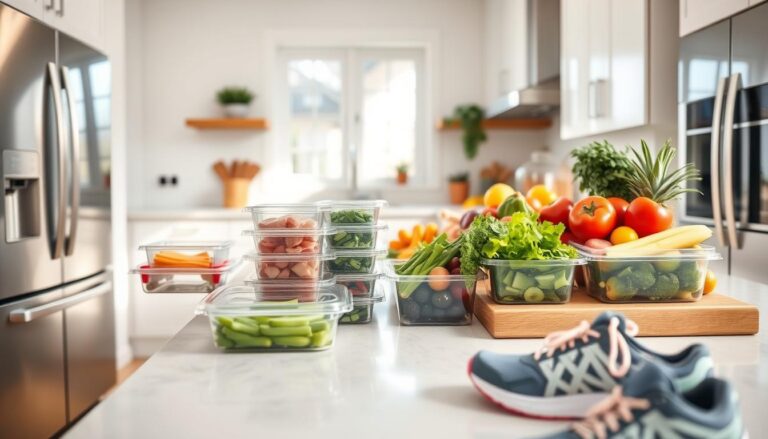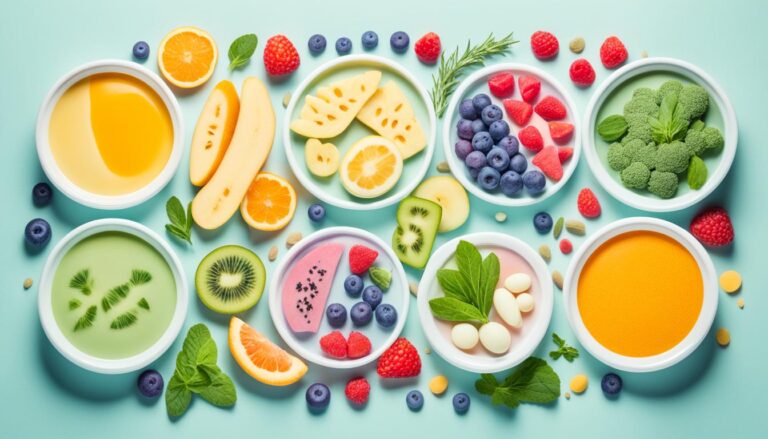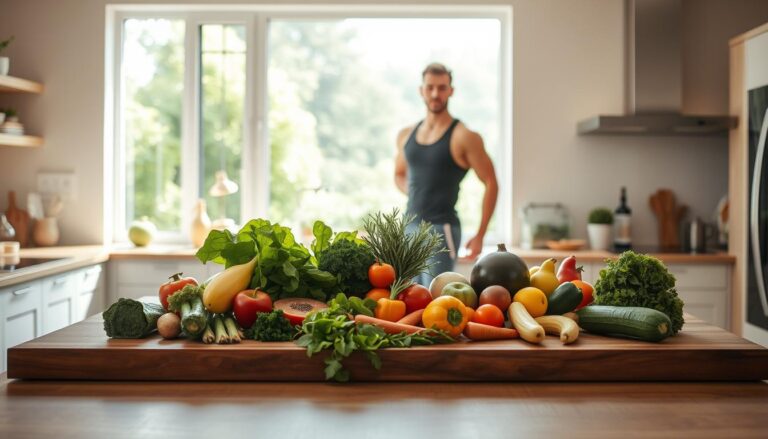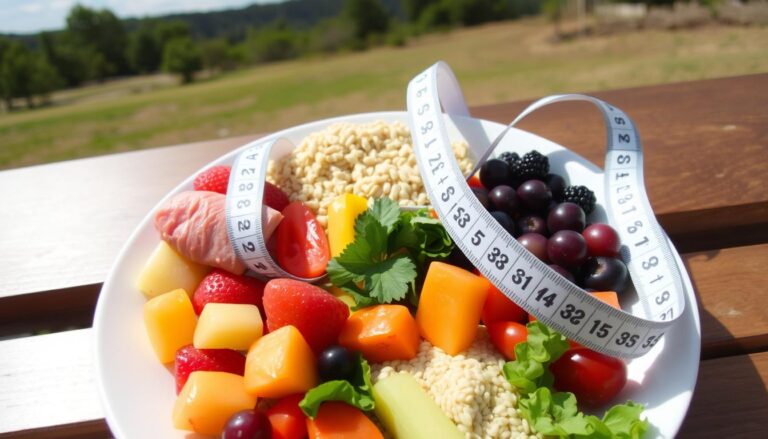What if your favorite warm-weather traditions could actually support your wellness journey? With backyard barbecues and ice cream trucks dominating the landscape, many assume vibrant health and seasonal fun can’t coexist. But science tells a different story.
The USDA’s food guidance has evolved dramatically since the early 1900s. From basic food groups to today’s MyPlate model, experts now emphasize balanced proportions and nutrient density. This approach becomes especially powerful when paired with nature’s warm-weather bounty.
Fresh berries, crisp vegetables, and hydrating melons flood markets during these months. Yet challenges like poolside snacks and festival foods test even disciplined eaters. The solution lies in strategic choices that honor both your body’s needs and summer’s social rhythm.
Key Takeaways
- Seasonal produce offers peak flavor and nutrition for balanced meals
- Hydration becomes crucial with increased heat and activity
- Modern dietary guidelines prioritize variety and portion control
- Food safety practices prevent warm-weather illnesses
- Social gatherings can align with wellness objectives
- Small substitutions maintain flavor while boosting nutrition
From farmers’ markets to beach picnics, this guide reveals how to navigate summer’s culinary landscape. Discover how updated nutrition science meets real-world practicality for lasting results.
Embrace a Balanced Summer Diet
Warm months bring fresh opportunities to revitalize your food choices. The USDA’s MyPlate model offers a science-based blueprint for meals that fuel outdoor activities while satisfying taste buds. This visual guide divides your plate into clear portions: 40% vegetables, 30% grains, 20% protein, and 10% fruits.

Modern Meal Design Made Simple
Start with vegetables as your foundation. Grill zucchini or toss leafy greens with olive oil for enhanced nutrient absorption. Whole grains like quinoa or brown rice provide lasting energy for beach days or hiking trips. Proteins become adventure-ready when you choose grilled chicken skewers or black bean burgers over fatty meats.
Upgrade Classic Cookout Staples
Transform traditional favorites using these swaps:
- Swap mayo-heavy potato salad for vinegar-based coleslaw
- Replace beef patties with turkey or lentil-based alternatives
- Offer fruit kebabs alongside dessert options
Reading nutrition labels helps identify hidden sugars in sauces and dressings. The crowding out method works beautifully at picnics – load half your plate with veggie-packed dishes first. Small changes create big impacts without sacrificing the social joy of shared meals.
Healthy Summer Eating Tips and Goals
Sunlit days call for culinary strategies that nourish both body and social life. Updated dietary frameworks like the MyPlate model prove particularly effective when paired with nature’s vibrant warm-weather offerings. Let’s explore practical approaches for balancing flavor and nutrition.
Incorporating MyPlate Principles Into Seasonal Meals
Transform your plate with sun-ripened produce. Eggplant and zucchini become star ingredients when grilled with olive oil and herbs. These vegetables deliver antioxidants and fiber with minimal calories – perfect for active days.
Build meals around colorful plant-based components. Try these adaptations:
- Swap pasta salads with spiralized cucumber ribbons
- Use roasted peppers as burger toppings instead of cheese
- Mix berries into whole-grain breakfast bowls
Managing Portions and Sugar in Warm-Weather Snacks
Sweet cravings intensify as temperatures rise. While fruits like watermelon provide hydration, their natural sugars require mindful consumption. A cup of grapes contains 23 grams of sugar – equivalent to 5.7 teaspoons.
Smart swaps maintain satisfaction without spikes:
- Pair Greek yogurt with raspberries instead of sugary toppings
- Freeze blended bananas for creamy dessert alternatives
- Infuse water with citrus slices rather than sweetened drinks
Portion control proves essential for traditional treats. Use small cups for ice cream and share festival foods. These tactics help maintain steady energy levels during extended outdoor activities.
Creative Summer Meal and Snack Ideas
Outdoor gatherings demand dishes that withstand heat while delivering bold taste. Our tested solutions combine convenience with nutritional balance, perfect for park outings or backyard feasts.

Grill-Friendly and Picnic-Ready Options
Skewers revolutionize portable veggie-based meals. Alternate zucchini coins with cherry tomatoes and mushrooms for quick-cooking kabobs. Pair with cooling dips like roasted red pepper hummus – these sauces stay fresh up to 4 hours outdoors.
| Meal Type | Top Choices | Benefits |
|---|---|---|
| Grilled Foods | Vegetable kabobs | Retains nutrients |
| Snack Options | Roasted chickpeas | High protein |
| Fruit Salad | Peach-mango mix | Natural sweetness |
| Plant Proteins | Marinated tempeh | Heat-stable |
Transform stone fruits into crowd-pleasers. Dice peaches with pineapple chunks and hint of lime zest for vibrant salsa. Serve over crispy rice cakes – a smart swap for calorie-dense chips.
Crunchy roasted chickpeas outshine traditional snacks. Season with smoked paprika for savory appeal or cinnamon for sweet cravings. Each half-cup portion packs 6g fiber – ideal for active days.
Cheese boards get a nutritional upgrade. Combine sharp cheddar with dried apricots and almonds. This trio delivers calcium, iron, and healthy fats without refrigeration worries.
Smart Hydration and Beverage Options
Balancing fluid intake with taste preferences becomes critical when temperatures soar. Rising mercury levels demand strategic approaches to maintain peak physical and mental performance throughout sun-drenched days.
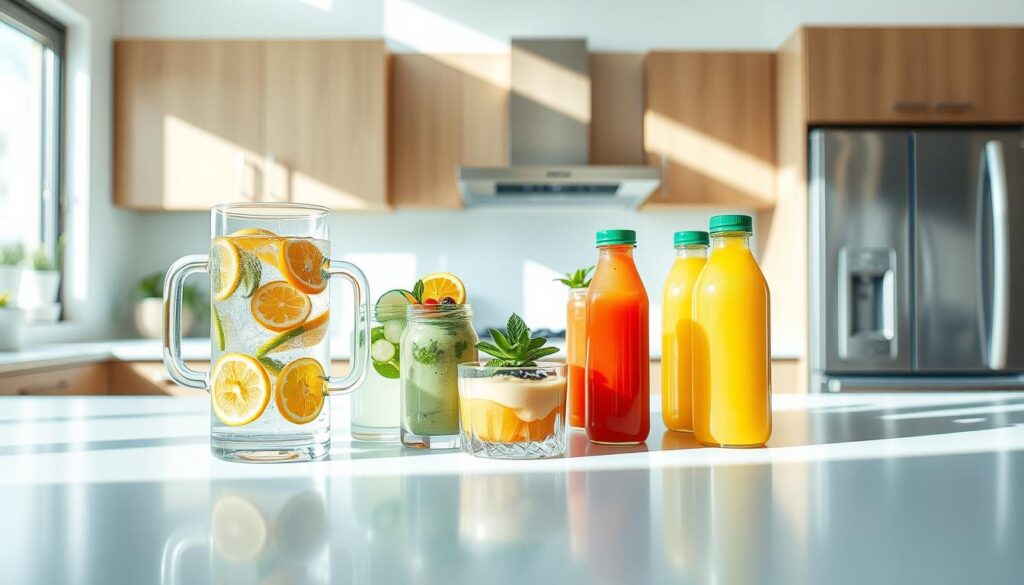
Choosing Water and Natural Enhancers
Experts recommend consuming eight 8-ounce glasses daily – about half a gallon – during warmer months. This baseline increases with extended outdoor time. Those spending over 30 minutes in the heat should drink a full glass immediately after coming indoors.
Enhance plain water with citrus slices or crushed mint. These additions provide flavor without added sugars. Sparkling varieties offer satisfying fizz while keeping hydration on track.
Navigating Beverage Pitfalls
Many low-fat drinks contain hidden sugars that counteract their perceived benefits. Always check labels for sweeteners like high-fructose corn syrup or artificial additives.
| Beverage Type | Smart Choice | Consideration |
|---|---|---|
| Alcohol | Club soda + fresh fruit | Alternate with water |
| Juices | Diluted with ice water | Limit to 4 oz servings |
| Sports Drinks | Electrolyte tablets | Only for intense activity |
| Flavored Waters | Unsweetened varieties | Avoid artificial colors |
For social events, implement a one-to-one ratio between alcoholic and non-alcoholic drinks. This practice maintains hydration while allowing participation in festive occasions.
Local & Seasonal Foods for Sustainable Health
Regional food systems transform how families approach warm-weather nutrition. Vibrant farmstands and markets bloom across communities during these days, offering sun-ripened treasures picked at peak freshness.
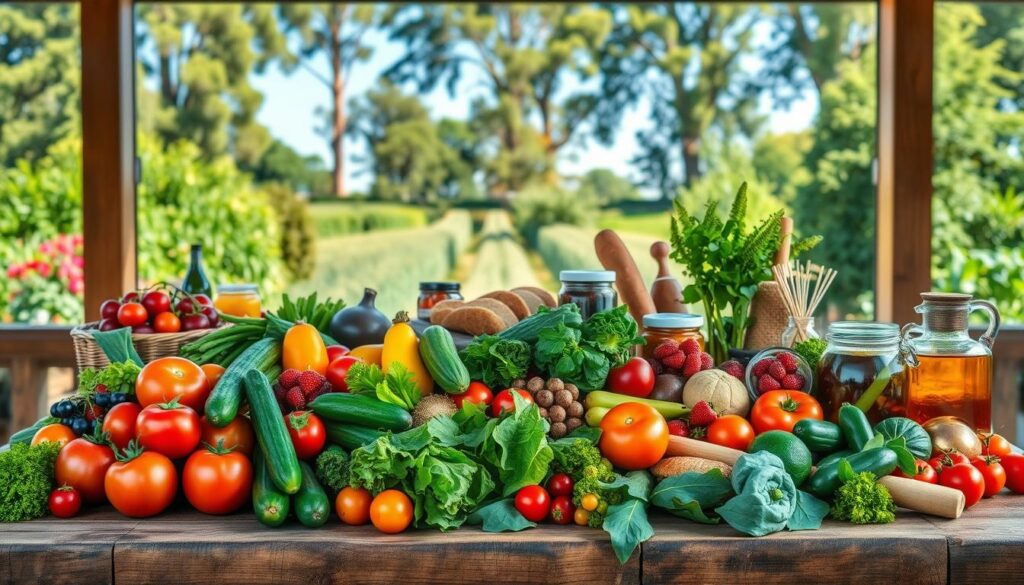
Why Nearby Harvests Outperform
Produce from neighborhood farms often reaches your table within 48 hours. This shortened time frame preserves up to 30% more nutrients compared to shipped alternatives, according to agricultural research. Irregular shapes and varied colors signal natural growth patterns – nature’s way of avoiding chemical enhancers.
Choosing local ingredients supports both personal wellness and community resources. Every dollar spent at farmers markets circulates three times within regional economies. Many supermarkets now highlight hometown harvests in dedicated sections – simply ask staff about nearby suppliers.
Engaging children in food sourcing builds lasting habits. U-pick berry patches and orchard days create hands-on learning experiences. Kids who participate show 68% greater willingness to try new fruits, recent studies reveal.
Seasonal eating simplifies meal planning while reducing environmental impact. Transportation distances shrink by 90% for local goods versus imported items. This time-tested approach nourishes families and ecosystems simultaneously, making your kitchen a hub for sustainable living.
Conclusion
Smart food choices during warmer months create lasting benefits for body and mind. Combining modern nutrition science with nature’s seasonal offerings turns meals into opportunities for vitality. Research confirms that balanced plates packed with fresh veggies and lean proteins boost energy levels while supporting overall health.
Hydration remains crucial in the heat. Infuse water with lemon slices or muddled mint for refreshing drinks that replace sugary alternatives. Watermelon becomes a triple threat – quenching thirst, providing nutrients, and satisfying sweet cravings naturally.
Family-friendly approaches make wellness sustainable. Grill colorful vegetable skewers together or blend frozen fruit for homemade snacks. These activities build healthy habits while maximizing summer’s extended daylight hours.
Every bite counts toward fueling adventures, from beach days to backyard gatherings. By prioritizing seasonal food resources and mindful portions, you’ll nourish both personal well-being and shared joy. The result? A season filled with flavor, energy, and meaningful connections.
